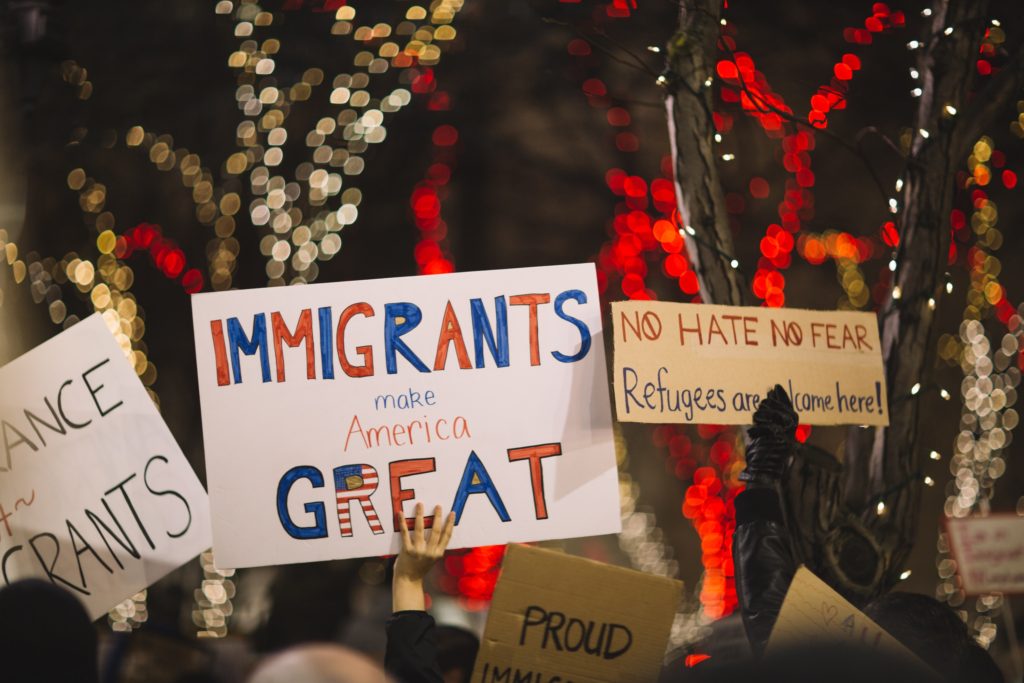How news coverage perpetuates harmful language about immigration
by: Sarah Han
posted on Thursday, February 28, 2019
A declaration of a “national emergency” at the border. A “zero tolerance policy” creating a crisis of separated and detained families and children. An attack on Deferred Action for Childhood Arrivals and Temporary Protected Status for refugees. These are just a few of the immigration-related developments that have garnered widespread media coverage in recent months. The national conversation about immigrants and immigration has reached a fever pitch, with each day bringing new headlines on a wide range of issues, including calls for increased deportations and threats to sanctuary cities, a government shutdown over funding for a wall that would disrupt entire communities and ecosystems, and a policy proposal that would force people to choose between accessing vital services and naturalization.
Federal policies are threatening immigrants’ dignity, security, and health, but is that the dominant narrative we see and hear in the news? Recent research published in the journal Politics, Groups, and Identities suggests it isn’t. Because news coverage provides a window into how the public and policymakers understand critical public health and social justice issues, we wanted to learn more about how immigration is portrayed by reporters. So, our researchers conducted an analysis of immigration-related articles, looking specifically at the news in four California counties with diverse political and social climates: Monterey, Sacramento, Kern, and San Diego.
We found that, from September 1, 2017 to August 31, 2018, news coverage was largely driven by federal actions and controversies coming out of the White House. Articles rarely quoted immigrants, leaving out the voices of the people who are affected most by these issues. What surprised us most, though, was the kind of dehumanizing, derogatory language still being used to talk about immigrants.

For years, advocates have been calling on news outlets to stop using terms like “illegal” and “aliens” to refer to people. And there has been progress: In 2013, Race Forward’s Drop the I-Word campaign was successful in getting major news outlets, including the Associated Press, to stop using these terms in their reporting. However, in our analysis of news coverage from Monterey, Sacramento, Kern, and San Diego, we found that many articles still contained this stigmatizing language.
For the most part, in the news coverage we examined, reporters weren’t using the problematic terms in their own writing, but it was still present in quotations from sources.
A lot of the dehumanizing language came directly from President Trump and his administration, who consistently used terms like “aliens,” “criminal aliens,” or even “illegals” to describe immigrants (in fact, at the direction of then-Attorney General Jeff Sessions, in July 2018, the Justice Department specifically instructed U.S. attorneys offices to only describe immigrants as “aliens”).
In the summer of 2018, during the height of public outrage about family separations at the border, the Monterey County Herald (along with many other news outlets) amplified a Tweet from President Trump using the term “illegals”: “Judges run the system and illegals and traffickers know how it works. They are just using children!” Many news outlets also printed letters to the editor that used these dehumanizing terms.
We wanted to know if this pattern was limited to the news coverage in the counties we had analyzed, or if it was a larger issue, so we expanded our analysis and looked at the language used in articles published in 2018 from top national newspapers. We found that on average, about 15% of articles about immigration contained derogatory, misleading, or racist terms in reference to immigrants. The New York Post, Washington Post blogs, The Washington Post, and The New York Times had the most articles with stigmatizing language about immigrants.

We found the same pattern in California newspapers. Just like in the top papers nationally, around 15% of articles (14.8%, to be exact) contained stigmatizing language about immigrants. The Chico Enterprise-Record, the Monterey County Herald, and Los Angeles Daily News were the most egregious offenders.
Language matters. “It’s the words and headlines used combined with the images and videos we see that perpetuate this otherizing of undocumented immigrants in our communities,” said veteran journalist and BMSG Strategic Communication Specialist Fernando Quintero. Quintero initiated a campaign to stop the use of the word “illegals” as a noun by media outlets when he served on the board of the National Association of Hispanic Journalists more than 20 years ago.
“A journalist’s role is to cut through jargon and report a fair and balanced story. When reporters incorporate terms like “illegals” or “aliens” or “caravans,” they are essentially using coded language presented as government jargon designed to dehumanize and demonize immigrants,” Quintero said. “And when they show only images of immigrants wading across the Rio Grande or scaling a border wall instead of showing and telling stories of individual families and children with dreams, that’s not journalism. That’s propaganda.”

And as Race Forward notes, racist rhetoric used in the media and political discourse has “paved the way for a rise in hate crimes against immigrants.”
We need to continue to put pressure on the media to avoid using stigmatizing language about immigrants. We can start by having conversations with news outlets, reporters, and editors about the language they use to describe immigrants.
While some news outlets — including the Los Angeles Times and USA Today — have pledged to stop using the i-word, others have created guidelines to avoid repeating stigmatizing language. For example, rather than using a direct quote, NPR‘s guidelines encourage journalists to paraphrase using neutral language when a government official’s statement includes terms like “illegal immigrants” or “illegal aliens.” Advocates can ask local news outlets about their guidelines for talking about immigrants and encourage them to adopt policies that limit the use of derogatory, dehumanizing language.
Advocates and activists can also help reduce stigma by training and supporting immigrants as they become spokespeople who can bring their voice the conversation. Reading stories from immigrants, their families, and communities from the border humanizes these issues for everyone, directly combating racist frames in the political discourse being reflected by the media.
For more information and recommendations for strengthening the narrative about immigration, see our report.



